Advertisements
Advertisements
प्रश्न
If the mid-points of the sides of a quadrilateral are joined in order, prove that the area of the parallelogram so formed will be half of the area of the given quadrilateral (Figure).
[Hint: Join BD and draw perpendicular from A on BD.]
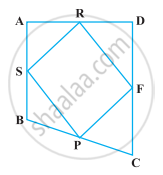
उत्तर
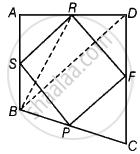
Given: Let ABCD is a quadrilateral and P, F, R and S are the mid-points of the sides BC, CD, AD and AB respectively and PFRS is a parallelogram.
To prove: ar (parallelogram PFRS) = `1/2` ar (quadrilateral ABCD)
Construction: Join BD and BR.
Proof: Median BR divides ΔBDA into two triangles of equal area.
∴ ar (ΔBRA) = `1/2` ar (ΔBDA) ...(i)
Similarly, median RS divides ΔBRA into two triangles of equal area.
∴ ar (ΔASR) = `1/2` ar (ΔBRA) ...(ii)
From equations (i) and (ii),
ar (ΔASR) = `1/4` ar (ΔBDA) ...(iii)
Similarly, ar (ΔCFP) = `1/4` ar (ΔBCD) ...(iv)
On adding equations (iii) and (iv), we get
ar (ΔASR) + ar (ΔCFP) = `1/4` ar (ΔBDA) ...[ar (ΔBDA) + ar (ΔBCD)]
⇒ ar (ΔASR) + ar (ΔCFP) = `1/4` ar (quadrilateral BCDA) ...(v)
Similarly, ar (ΔDRF) + ar (ΔBSP) = `1/4` ar (quadrilateral BCDA) ...(vi)
On adding equations (v) and (vi), we get
ar (ΔASR) + ar (ΔCFP) + ar (ΔDRF) + ar (ΔBSP) = `1/2` ar (quadrilateral BCDA) ...(vii)
But ar (ΔASR) + ar (ΔCFP) + ar (ΔDRF) + ar (ΔBSP) + ar (parallelogram PFRS) = ar (quadrialateral BCDA) ...(viii)
On subtracting equation (vii) from equation (viii), we get
ar (parallelogram PFRS) = `1/2` ar (quadrilateral BCDA)
Hence proved.
APPEARS IN
संबंधित प्रश्न
In the given figure, ABCD is parallelogram, AE ⊥ DC and CF ⊥ AD. If AB = 16 cm, AE = 8 cm and CF = 10 cm, find AD.
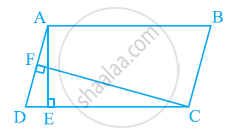
If E, F, G and H are respectively the mid-points of the sides of a parallelogram ABCD show that ar (EFGH) = 1/2ar (ABCD)
In the following figure, ABCD, DCFE and ABFE are parallelograms. Show that ar (ADE) = ar (BCF).
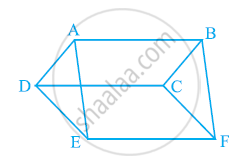
In the given below fig. ABCD, ABFE and CDEF are parallelograms. Prove that ar (ΔADE)
= ar (ΔBCF)
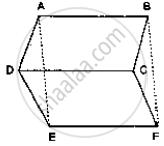
ABCD is a parallelogram, G is the point on AB such that AG = 2 GB, E is a point of DC
such that CE = 2DE and F is the point of BC such that BF = 2FC. Prove that:
(1) ar ( ADEG) = ar (GBCD)
(2) ar (ΔEGB) = `1/6` ar (ABCD)
(3) ar (ΔEFC) = `1/2` ar (ΔEBF)
(4) ar (ΔEBG) = ar (ΔEFC)
(5)ΔFind what portion of the area of parallelogram is the area of EFG.
In which of the following figures, you find two polygons on the same base and between the same parallels?
Two parallelograms are on equal bases and between the same parallels. The ratio of their areas is ______.
In the following figure, PSDA is a parallelogram. Points Q and R are taken on PS such that PQ = QR = RS and PA || QB || RC. Prove that ar (PQE) = ar (CFD).

ABCD is a parallelogram in which BC is produced to E such that CE = BC (Figure). AE intersects CD at F. If ar (DFB) = 3 cm2, find the area of the parallelogram ABCD.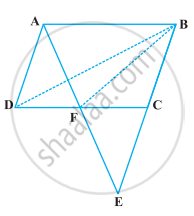
ABCD is a trapezium in which AB || DC, DC = 30 cm and AB = 50 cm. If X and Y are, respectively the mid-points of AD and BC, prove that ar (DCYX) = `7/9` ar (XYBA)
